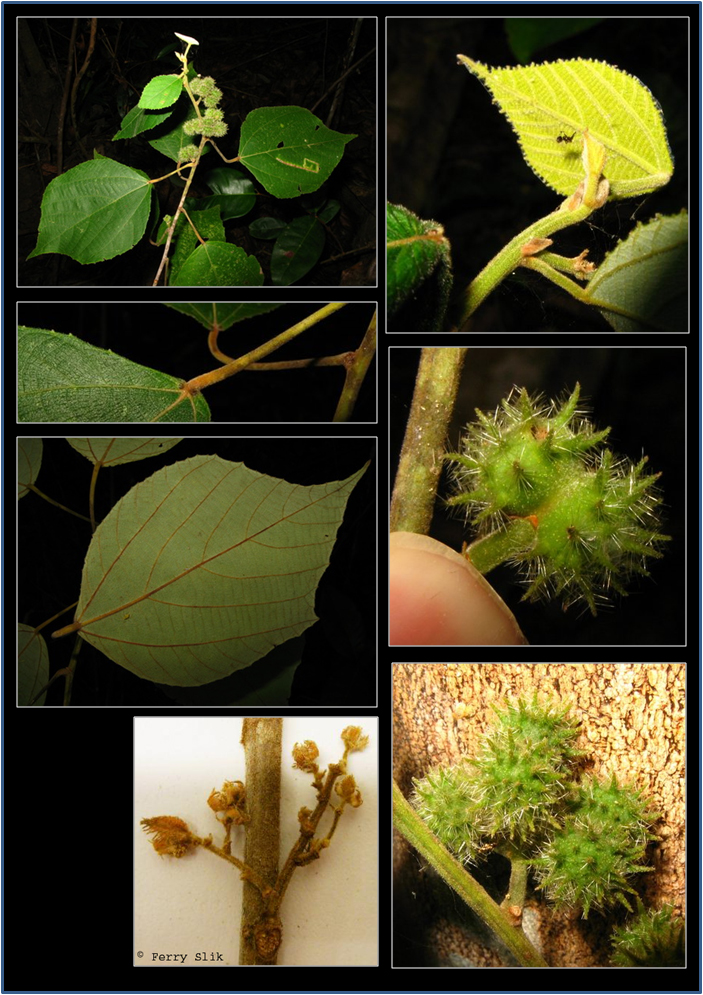Macaranga trichocarpa (Reichb.f. & Zoll.) Mull.Arg., in DC. Prodr. 15, 2 (1866)
Latin for 'hairy fruits'.Synonyms
Macaranga borneensis Müll.Arg.
Macaranga helferi Müll.Arg.
Macaranga minutiflora Mull.Arg.
Macaranga trichocarpa var. trilobulata Gagnep.
Mappa trichocarpa Reichb.f. & Zoll.
Mappa zollingeriana Miq.
Tanarius borneensis (Müll.Arg.) Kuntze
Tanarius helferi (Müll.Arg.) Kuntze
Tanarius minutiflorus (Müll.Arg.) Kuntze
Tanarius trichocarpus (Zoll.) Kuntze
Diagnostics
Shrub up to 7 m tall and 6 cm dbh. Twigs solid and hairy. Stipules ca. 5 mm
long, dropped early. Leaves alternate, simple, tripli-veined, hairy (sandpaper
like) on upper and lower surface, with two basal nectary glands on upper
surface. Flowers ca. 0.5 mm diameter, green-yellowish, plaved in bundles within
fimbriate bracts which are part of short racemes or panicles. Fruits ca. 10 mm
diameter, green-silvery, 2-lobed, dehiscent, spiny capsules covered with
irritating hairs.
Description
Bushy trees, to 6 m, with sprawling limbs (sarmentose). Bark smooth, orange brown, latex clear
turning red. Twigs solid, slender, 3 mm diam., terete, smooth, finely pubescent. Stipules elliptic,
5 mm, papery, pubescent, erect, very soon caducous. Leaves: petioles 4-5 cm, slender, terete, finely
pubescent, sometimes weakly kneed at top; blades rhombic-ovate, very occasionally with 2 lateral
cusps or small lobes, 7-14(-17) by 4-10(-15) cm, thinly leathery, base truncate to very broadly
rounded, often under 1 mm peltate, occasionally with inconspicuous glands on nerves near petiole
insertion, margin with small glandular teeth, apex acute or acuminate, drying khaki below and often
dark brown above, below granular glandular and velvety with short spreading white hairs on all
nerves including the raised reticulum, with 3 main and several minor nerves at petiole insertion,
surface above with white hairs (caducous except on nerves) arising from small persistent pustules.
Inflorescences diffuse narrow racemes to 6 cm; branches sparse to 15 mm; peduncle short, 1 cm; axes
slender, main axis terete, finely pubescent, lower branches alternate; bracts elliptic, 5 mm,
dentate, leaf-like, pubescent, with pinnate nervation, sometimes stalked, soon caducous; flower
clusters in groups, smaller than bracteoles, overlapping, branches developing through flower
clusters (as M. tanarius); bracteoles persistent, ovate, strongly concave, to 4 by 2mm, apex acute,
pectinate, pubescent on both sides, nerved. Staminate flowers c. 14 per cluster, maturing in
sequence; pedicel 0.5 mm, tomentose; sepals united, elliptic, tomentose; stamens 2, strongly
exserted, 0.5 mm long, anthers 4-locular. Pistillate flowers similar [to staminate?], ovary bilobed.
Fruits round (or bilobed), 4 mm diam., woody, golden granular glandular, with close short spines
bearing conspicuous glassy irritant hairs; pedicel 3 mm, pubescent; calyx small, persistent. Seeds
round, 2 mm, very finely verrucose, with sarcotesta. [from Flora Malesiana]
Ecology
Usually gregarious in severely disturbed mixed dipterocarp forests, but
sometimes also found in the understorey, up to 600 m altitude. Locally common in
scrub, along roadsides and forest edges, mostly on hillsides and ridges.
Distribution
India, Burma, Indo-China, Thailand, Peninsular Malaysia, Sumatra, Borneo.
